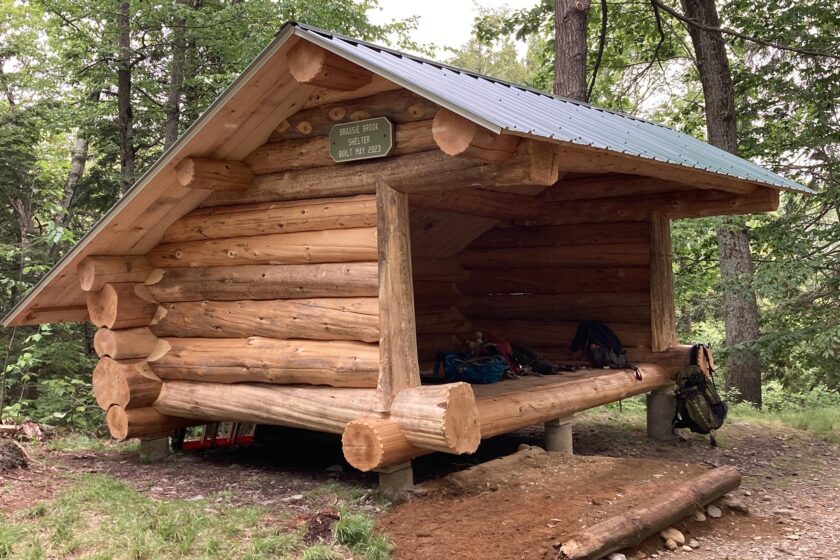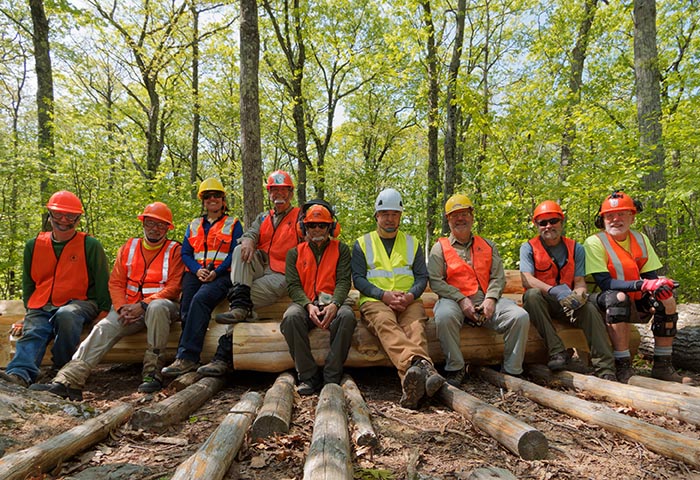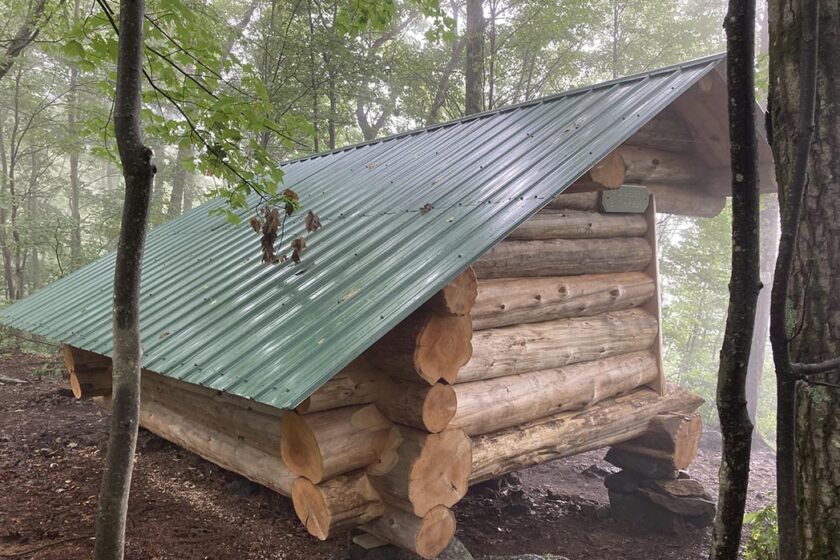Cooperative Trail Management in Action
The Making of an A.T. Shelter
November 30, 2023
Visitors who spend the night in an Appalachian Trail shelter—or who rest and rejuvenate there for any amount of time—likely do not wonder how the shelter came to be. Most do not pause to consider how the wood and other materials got to the site, or who planned and built the shelter, or who maintains it throughout its decades of existence.
Perhaps that is as it should be. The A.T. is meant to provide an opportunity to enjoy simplicity, self-reliance, and connection with nature. The evidence of human intervention in creating that experience is intentionally minimal—except when necessary for safety and ease of use.
The truth, however, is that thousands of people from dozens of organizations, agencies, and other entities work collaboratively every year to ensure the Trail remains a world-class outdoor recreational experience. The replacement earlier this year of two popular shelters in Connecticut gives us a chance to peek behind the curtain of cooperative management of the A.T.
How to Replace an A.T. Shelter… in 10 Steps
Step 1: Identify the Need for a New Structure
In 2018, volunteers with the AMC-CT Appalachian Trail Club working with Adam Brown, former ATC Regional Manager, recognized that two popular shelters on the A.T. were nearing the end of their life. After 40 years of service, the original Brassie Brook and Riga shelters had suffered from the cumulative impacts of weather, a small fire, pests, and general wear-and-tear.
Step 2: Submit a Request for Funding
The ATC and its partners prepared and submitted a request for funding to the National Park Service. This involved gathering information about shelter design and replacement costs; creating a work plan; consulting with interested parties, such as environmental experts and tribal councils; conducting botanical reviews of the sites; and more. Once the project was funded, the ATC’s Vice President of Trail Management, Hawk Metheny, and the Regional Manager for Southern Vermont, Massachusetts, and Connecticut, Tracy Lind, co-managed the process to build the shelters.
Step 3: Ensure Park Service Compliance
National Park Service staff assessed the project to ensure minimal impact on natural and cultural resources and provided the opportunity for all interested parties to provide input on the project. To accommodate the intended airlift of materials, Marian Orlousky and Dan Hale of the ATC conducted a botanical survey to verify that no rare or endangered species would be threatened.
Step 4: Purchase the Materials

The vendor Woodlot Woodworks LLC was engaged to build two Adirondack shelter kits fitted specifically to each site and designed to blend into the environment. Both shelters are made with cedar logs, which deter pests and withstand weathering better than other natural wood. Each log was hand cut to fit perfectly onto the other without any gaps and was scribed for reassembly at the shelter sites. Tracy Lind and volunteers visited Woodlot Woodworks twice – once to discuss the project, and again to learn how to assemble the shelters at the A.T. sites.
Step 5: Airlift the Materials to the Site
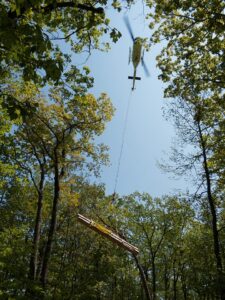 Maine Helicopters conducted an airlift operation to deliver about 7,000-pound loads of cedar logs and other materials for the Brassie Brook shelter site. The components arrived in September 2022, but the project was unexpectedly postponed at the last minute.
Maine Helicopters conducted an airlift operation to deliver about 7,000-pound loads of cedar logs and other materials for the Brassie Brook shelter site. The components arrived in September 2022, but the project was unexpectedly postponed at the last minute.
Step 6: Secure Temporary Storage
Because of the postponement, the new shelter materials needed to be protected for the winter. Where could an 18-foot disassembled shelter be stored, and how could it be transported? A neighbor came to the rescue—with a barn just down the road from the project site. Volunteers transported the materials to and from the barn.
Step 7: Tear Down the Old Structure

Once compliance was ensured, work began to remove the old shelters. Volunteers hiked almost 2 miles in and out to each site carrying tools and personal protection equipment to get to work. After breaking down the shelters, the team cut and dispersed the native logs throughout the forest so they could revert back to nature. The former shelter roofing and other deconstruction waste were bagged for removal, again by helicopter.
Step 8: Airlift the Materials to the Second Site
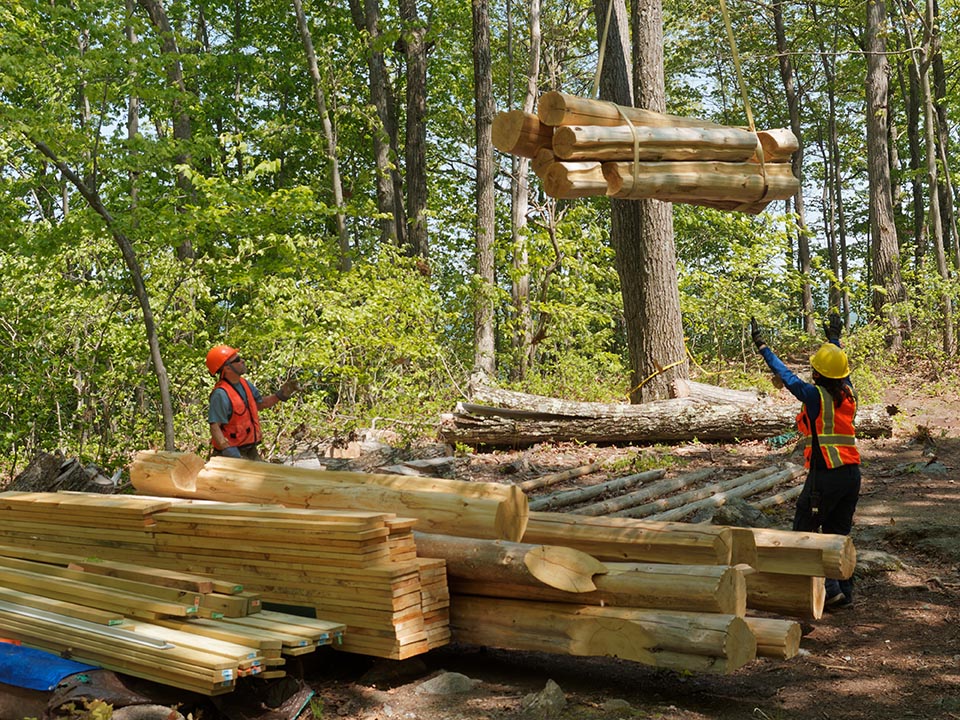
During April and May 2023, the Riga shelter components were delivered by Maine Helicopters, and volunteers brought the Brassie Brook Shelter kit back from the neighbor’s barn to the project staging site.
Step 9: Build the Shelter in Situ
Construction took place from May to July 2023. Once the first logs were leveled and squared on their foundations, the floor was installed, then the cedar logs for the back and sides were fit in to one another and secured with structural screws. After that the purlins and ridge pole were placed and the roofing installed. The finishing touches were hanging new shelter signs and register boxes.
Step 10: Ensure Access and Open the New Shelter

Due to the sloping site at the Riga Shelter, a ramp was installed, instead of stairs, to ensure every visitor can access the shelter. The new Brassie Brook Shelter came into service in early June 2023, followed some six weeks later by the Riga Shelter.
The Heart and Soul of the Trail
Since the A.T.’s inception, volunteers have been its heart and soul. Both protection and maintenance of the Trail rely upon grassroots support provided by thousands of individuals who contribute their time and sweat to coordinating projects and doing work on the ground.
To replace the two shelters in Connecticut, it took dozens of volunteers dedicating 1,214 hours of service over 21 days (spread across five years). And it took the leadership, financial support, and professional expertise provided by the National Park Service and the ATC to ensure the projects’ successful completion.
So the next time you stop at a shelter, or walk up rock steps that were meticulously placed in the perfect spot, or linger on a footbridge over a frothing stream, take a minute to think about the hundreds of hands at work behind the scenes. Consider becoming an A.T. volunteer to help maintain and protect the Trail. Or just enjoy the experience.

